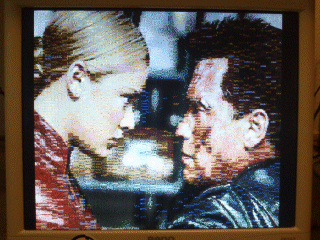|
| |
Credits :
Download :
Look for downloads on external sites:
Pokefinder.org
Production Info
Submitted by tokra on 21 September 2013
The idea for this small demo came out of a discussion on the commodore128.org-forum about connecting the C128 to a VGA-monitor in the 80-column mode which the VDC chip produces:
http://www.commodore128.org/index.php?topic=3877
The C128 in 80-column-mode puts out a signal that is pretty much like the old CGA of early IBM PCs. You have a horizontal frequency of about 15.7kHz and a vertical frequency of 60Hz for NTSC and 50Hz for PAL making it possible to display such a signal on a TV relatively easily as well.
Also, the signal is digital (RGBI). You have 8 colors with (RGB) with intensity (I) either turned on or off for a total of 16 colors.
Now, VGA has horizontal frequency of 31.5 kHz (roughly twice as much as the C128) and colors are analog RGB. To be able to display a C128's signal on VGA you need to double the horizontal frequency as well as convert the 16 digital colors to analog values.
The frequency doubling is usually done by a line-doubler like the GBS-8220. This uses digital signal processing to create a completely new picture out of the data it receives.
The color-conversion from digital RGBI to analog RGB can be done in several ways. The easiest solution is to just connect the R, G and B like with this cable:
http://www.ambery.com/db9todbadca.html
You get only 8 out of 16 colors this way and the signal levels will be way to high (RGBI uses 5V-levels, while VGA uses 0.7V). While this works for a first test this is obviously not the desired solution.
An easy and cheap enough solution is a small resistor-network of which several layouts can be found around the internet. A very good explanation can be found at Hydrophilic's site:
https://sites.google.com/site/h2obsession/CBM/C128/rgbi-to-vga
This way you get 16 colors, although you get the color dark-yellow instead of brown. The color brown is a special case, you can read about that in Wikipedia:
http://en.wikipedia.org/wiki/Color_Graphics_Adapter#With_an_RGB..
The most elegant RGBI->RGBA conversion I have seen yet was provided by Richard42 in the commodore128.org-forum. This also includes a fix for the color brown. Read more about this in the forum-thread mentioned at the start.
Now, to get back to what this program actually does: It alleviates the need for the digital signal-processing or line doubler (for which you would need the GBS-8220) by putting the VDC into a mode of nearly 31.5kHz and 60Hz which VGA-monitors will recognize. While you still need the conversion of the color from digital to analog, the VDC-chip will actually provide the signal that is displayed on the VGA-monitor. |
|
|
|
 | Search CSDb |
 |
|
 | Navigate |  |
|
 | Detailed Info |  |
|
 | Fun Stuff |  |
· Goofs
· Hidden Parts
· Trivia
|
|
 | Forum |  |
|
 | Info on other sites |  |
|
 | Support CSDb |  |
|
 |  |
|


